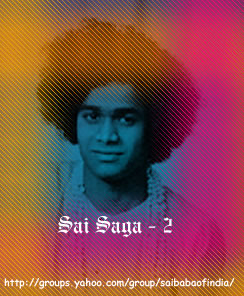|
The
Divine child became the pet of the entire village of Puttaparthi and
the ryots and cowherds vied with each other in fondling it and feeding
it and playing with its lovely silken curls. Its charming smile
attracted every one. The fragrance of the jasmine bud filled the air.
Like a lighted lamp, Sathya moved about the house and laughter tinkled
in the street when he lisped his sweet vocabulary of sounds.
He kept away from places where pigs or sheep or cattle or fowl were
killed or tortured, or where fish was trapped or caught; he avoided
kitchens and vessels used for cooking flesh or fowl. When a bird was
selected and talked about by someone in connection with dinner,
Sathyanarayana the little boy, would run towards it and clasp it to
His bosom and fondle it as if the extra love He poured on it would
induce the elders to relent and spare the fowl. He was called by the
neighbours, "Brahmajnani" on account of this type of aversion and this
measure of Love towards creation. At such times, the boy used to run
to the Karnam's house for they were Brahmins and vegetarians, and take
the food offered by Subbamma, the aged lady residing there. So
distinct was his behaviour that a wag once nicknamed him "the Brahmin
child"! Yes, it was a fitting description. Little did that wag know
that, while in the previous body, this child, so laughed at now, had
declared at Shirdi "This Brahmin can bring lakhs of men on the White
path and take them to their destination!"
Charity begins at Home
At the tender age of three and four, "this Brahmin" behaved as if it
had a heart that melted at human suffering. Whenever a beggar appeared
at the door and raised his cry, Sathya left off play and rushed in, to
force his sisters to dole out grain or food. The adults were naturally
irritated by the endless procession of outstretched hands; they easily
lost temper; they sometimes shouted the beggar off, before Sathya
could bring relief; this made the child weep so long and loud that
only by bringing the dismissed beggar back could the elders stop the
wailing. Sometimes, in order to put a stop to what the elders thought
'this expensive and misplaced charity,' the mother caught, hold of the
child and with a finger raised in warning, she said, "Look here! You
may give him food; but, mind you, you will have to starve." That did
not daunt the child; he used to run inside and bring out food to the
hungry man at the door; and stay away from dinner or lunch, himself.
Nothing and nobody could persuade him to come to his plate, which was
left untouched! When Sathya began running about in the street, he
sought out the maimed, the blind, the decrepit and the diseased, and
led them by the hand to the doorstep of the parents; the sisters had
to discover from the store or the kitchen some grain or food and put
it into the beggar's bowl while 'the little master' looked on, gladly.
There is a small primary school in the village of Puttaparthi, and
Sathya used to go there with his contemporaries, for something nobler
than learning to spell and scribe. The school had at that time an
interesting scheme of punishment to ensure punctuality. The lucky
child which first comes in and salutes the teacher, as well as the
fellow who gets in second, are exempt from the punishment; but every
chap, who for whatever reason, legitimate or other, arrives late, is
given a taste of the cane, the number of cuts depending on his place
in the list of late-comers, the later the larger. In order to escape
from this torture, the children gathered under the eaves of the
schoolhouse, much before sunrise, in rain or in fog. Sathya saw their
plight and sympathised with his shivering playmates. He visited them
under the eaves and, bringing shirts, and towels and dhotis from his
house; he covered the boys and made them comfortable. |
